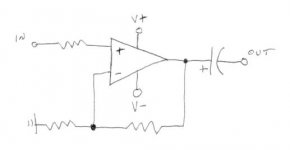Just wondering, if implementing a power opamp which uses BOTH a bipolar power supply and a big electrolytic to AC couple the output, are any special tricks required to guarantee a bias across the cap? Something like diodes from each rail to the opamp output? Sorry if this seems like a trivial question, but I had trouble searching for this info.
If you need much voltage swing, don't use a polarized cap. If the required output voltage swing (peak) is much smaller than your supply rails, you could create an intentional DC offset.
But a much better solution is to use audio-grade bipolar electrolytics (search on Mouser.com for "audio electrolytic" or "muse") or a film capacitor depending on the value needed.
If you explain more about your application it would help? What lower cutoff frequency do you need? What impedance would the cap see in whatever it's driving?
But a much better solution is to use audio-grade bipolar electrolytics (search on Mouser.com for "audio electrolytic" or "muse") or a film capacitor depending on the value needed.
If you explain more about your application it would help? What lower cutoff frequency do you need? What impedance would the cap see in whatever it's driving?
Thanks for your reply. As for application, it is a DIY guitar practice amp with an LM3875 for the output. Rails are roughly +/-25VDC The reason for the bipolar PS is that it keeps parts count down as I don't have to bias and AC couple the front end stages. The reason for the big electrolytic is to preclude any thump or DC of any kind on the speaker. A big electrolytic is cheap, and the negatives don't really come into play for a guitar amp, so that's what I want to use.
Attachments
Go for it,no biasing or anything is needed. Just make sure the input to the next (power) amp stage isn't floating,and you're good.
Surely it would make sense to use two small cheap ordinary electrolytic capacitors to AC couple the input and a capacitor in the feedback path than one large more expensive capacitor in the output?
The LM3875 has pretty low offset when done this way, and no thump. I use an LM3886 in a similar fashion and get no poweron/off thumps. I do not use the Mute pin on that chip (just 22K to -V, no capacitor)
The LM3875 has pretty low offset when done this way, and no thump. I use an LM3886 in a similar fashion and get no poweron/off thumps. I do not use the Mute pin on that chip (just 22K to -V, no capacitor)
- Status
- Not open for further replies.
- Home
- Amplifiers
- Solid State
- Bipolar PS plus AC coupled output from opamp?

